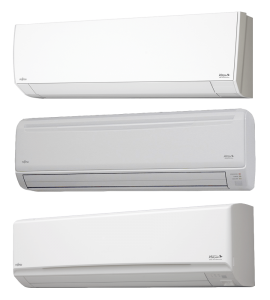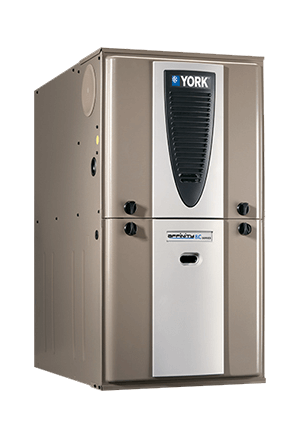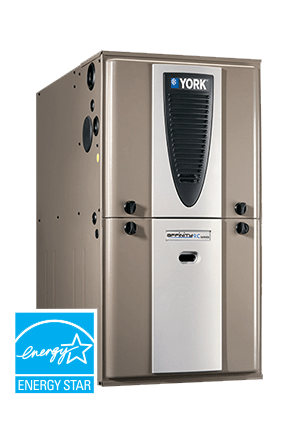To familiarize yourself with the equipment used in typical HVAC projects, here are definitions of common terms.
Annual Fuel Utilization Efficiency. A measure of a furnace’s heating efficiency. The higher the AFUE%, the more efficient the product. The government’s established minimum AFUE rating for non-weatherized gas furnaces vented through a chimney is now 81%.
: The portion of the central air conditioning or heat pump system that moves heated or cooled air throughout a home’s ductwork. In some systems a furnace handles this function.
: An outdoor temperature, usually between 30℉ and 45℉, at which a heat pump’s output exactly equals the heating needs of the home. Below the balance point, supplementary electric resistance heat is needed to maintain indoor comfort.
: British thermal unit. The amount of heat required to raise the temperature of one pound of water (about one pint) by one degree F.
: The pump that moves the refrigerant from the indoor evaporator coil to the outdoor condensing unit and back to the evaporator. The compressor functions as the heart of the system, because it circulates the refrigerant in a loop.
: The portion of a central air conditioning system that is located outside the home and functions as a heat transfer point for collecting heat from and dispelling heat to the outside air.
: A network of refrigerant-filled tubes where heat leaves the hot refrigerant vapor. The vapor then condenses into a liquid capable of absorbing more heat.
: The portion of a heat pump or central air conditioning system that is located in the home and functions as the heat transfer point for warming or cooling indoor air.
: An air conditioner that contains a valve that allows it to alternate between heating and cooling.
: A body of air or liquid from which heat is collected. With Coleman® heat pumps, the air outside the home is used as the heat source during the heating cycle.
: Heating Seasonal Performance Factor. A measure of a heat pump’s heating efficiency. The higher the HSPF, the more efficient the product. There is no government established minimum HSPF rating for heat pumps.
: Seasonal Energy Efficiency Ratio. A measure of an air conditioner’s cooling efficiency. The higher the SEER, the more efficient the product.
: A year-round heating and air conditioning system that has all of the components completely encased in one unit outside the home.
: A heat pump or central air conditioning system with components located both inside and outside the home. The most common design for home use.
: The auxiliary or emergency heat, usually electrical resistance heat, provided at temperatures below a heat pump’s balance point.
You might think of your heating and cooling system as just a “BOX” that can be turned “ON” and “OFF” in order to control your home temperature, but your system is a lot more than that. It has an impact on the air that you breathe, the moisture and mold growth, the amount of energy that you use, the un necessary expenses that you carry, and most importantly, on your and your family’s health.
Just like your car, your home comfort system needs routine maintenance to keep it running at its best. Without regular maintenance, heating and cooling systems waste energy and are ore likely to break down. With the proper attention however, they can they can keep you comfortable year round. A system which is not running in top shape, is one that is costing you money every month.
Here is a list of tips for those who want to know what their system needs for best possible performance
During very high ambient temperature (above 30 C), air conditioning unit are
Not working with design temperature, because most of them are sized on an
ambient of 26 ℃.
We advise you not to set A/C units to work below ℃, because it could lead to problems. If you do so to speed up cooling, it could lead the evaporator coil to freeze-up during cooler ambient temperature.
If the A/C unit is too large, there will be a problem, because it may not cool uniformly or provide proper dehumidification.
Set the fan on low speed in humid weather to remove moisture from the air, which will make it feel cooler.
Clear the furniture away from air conditioning vents.
Weather-strip door and windows.
Keep windows closed and draperies, blinds, and shades drown.
Check the air filter once a month and clean or replace them when necessary, because dusty filters reduce air flow and unit will consume excess energy.
Clear grass, shrubs, leaves and other obstruction from the area around the outside of condensing unit. It must have unobstructed air flow all around to dissipate the heat that is being removed from inside.
The axle should be lubricated, and blades cleaned
The fan belt should be adjusted so it deflects no more than an inch when pressed
While thermostats rarely fail, they can degrade over time. Faulty thermostats can send faulty signals to the system thinking the room is warmer or colder than it really is.
Houses with forced-air furnaces have an air filter to keep it and its duct work clean. This filter sits in between the main return duct and the furnace cabinet at the blower side. This filter should be kept clean all year round on heating and cooling seasons.
Media filters are made of deeply pleated, paper-like material, and media particles.
Media filter can cover up to 75 square feet when stretched out. This increased area of filtration will increase the life of the filter.
Choose a filter that matches your blower capacity.
Before calling for service, check the following:
Check the power supply
Check the selections on thermostat (“HEAT” for heating,” COOL” for cooling)
Check the setting on thermostat. On “HEAT” the setting should be higher than the room
Temperature to have the heating system running and on “COOL” the thermostat setting should
Be lower than the room temperature.
Check that blower compartment door is properly aligned, in place, and secure
Check for a possible blown fuse or tripped circuit breaker
Under the Montreal Protocol, developed nations are obligated to achieve a certain percentage of progress toward the total phase out of HCFC’s by certain dates.
These nations use the cap as a baseline to measure their progress toward achieving the percentage goals.
HCFC Phase out Schedule
January 2010: A ban on the manufacture of new equipment using R-22
January 2020: End of production of HCFC’s except R-123
January 2020: A ban on the manufacture of new equipment using R-123
January 2030: End of production and importation of R-123

HCFC Consumption Phase out
2004: 35% reduction vs. cap
2010: 65% reduction vs. cap
2015: 90% reduction vs. cap
2020: 99.6% phase out (except R-123)
2030: 100% complete phase out
When compare the Scroll Compressor to the Piston one, the scroll offers several significant advantages:
1- Scroll Compressor is simple. It has fewer parts to compress the gas- two parts compare to
Fifteen parts in a piston compressor.
2- Scroll Compressor is quieter. Because there is a few moving parts in scroll, this compressor
is quiet and because the compression is continuous, there is no pulsation and valve noise.
3- Scroll Compressor is efficient. Because of the type of operation, scroll compressor has less
heat transfer between suction and discharge gas. This, plus more detailed factors make
scroll 10-15% more efficient than piston compressor.
Prepared by Air Flow Heating & Cooling Ltd. | Copyrighted content, see Terms of Use policy
here
Any other questions not provided here, Call us at:
905-507-2665 or E-Mail us at:
info@air-flow.ca














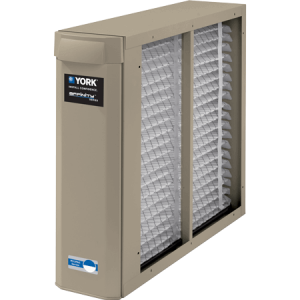



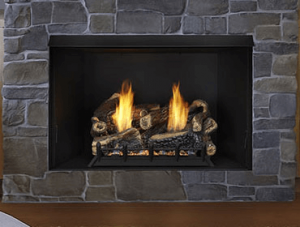




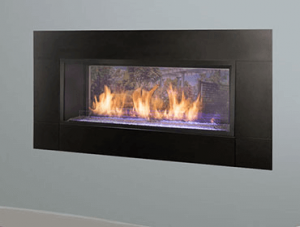







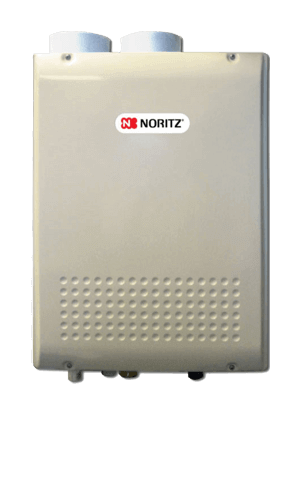






 The ENERGY STAR rated NRC661, Noritz’s newest efficient condensing model with a half inch gas line. Featuring the same energy-saving condensing technology as the rest of the Noritz eco-TOUGH? Series of gas-fired residential tankless water heaters, the NRC661 has an Energy Factor of 0.91 for natural gas and 0.93 for LP. These ratings are nearly 10 points higher than that of a comparably sized, conventional tankless unit, and approximately 30 points higher than a standard, tank-type gas-fired water heater. With a maximum input of 120,000 BTU per hour (BTUh), using a half-inch gas line up to 120 feet in length. A new, more accurate interpretation of the National Fuel Gas Code permits the use of the smaller-diameter gas piping for inputs up to 174,000 BTUh, as long as the water column pressure at the inlet of the unit is a minimum eight inches.
The ENERGY STAR rated NRC661, Noritz’s newest efficient condensing model with a half inch gas line. Featuring the same energy-saving condensing technology as the rest of the Noritz eco-TOUGH? Series of gas-fired residential tankless water heaters, the NRC661 has an Energy Factor of 0.91 for natural gas and 0.93 for LP. These ratings are nearly 10 points higher than that of a comparably sized, conventional tankless unit, and approximately 30 points higher than a standard, tank-type gas-fired water heater. With a maximum input of 120,000 BTU per hour (BTUh), using a half-inch gas line up to 120 feet in length. A new, more accurate interpretation of the National Fuel Gas Code permits the use of the smaller-diameter gas piping for inputs up to 174,000 BTUh, as long as the water column pressure at the inlet of the unit is a minimum eight inches.


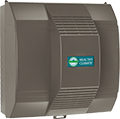






























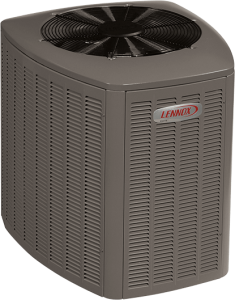









 Ceiling Mounted Single Zone products offered by LG Air Conditioning Technologies for Residential and Light Commercial applications.
Ceiling Mounted Single Zone products offered by LG Air Conditioning Technologies for Residential and Light Commercial applications.

